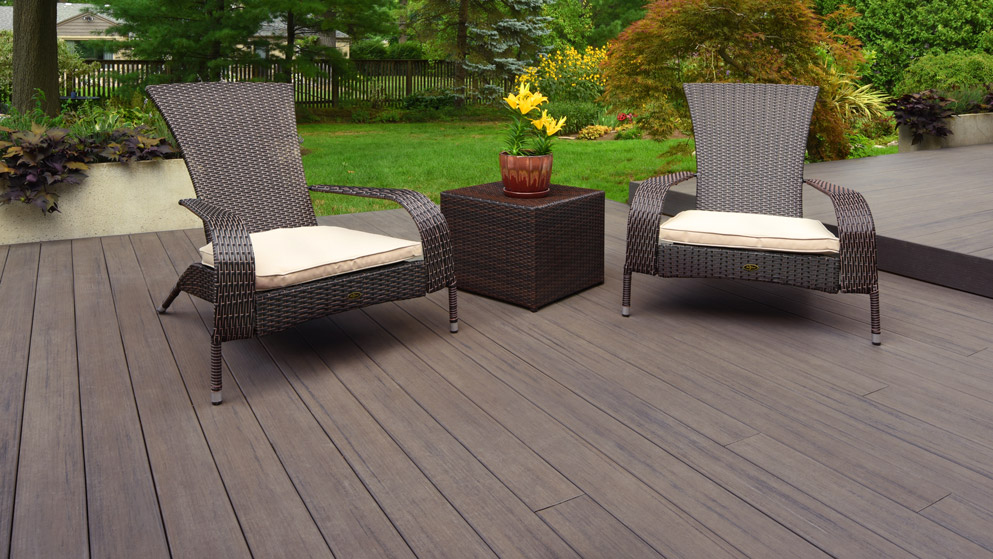Composite Decking: The Eco-Friendly Deck Board Option
Many common building materials, from lumber to stones, can have a significant negative impact on the environment. But more and more environmentally-conscious consumers have started to look for alternatives - building materials they can feel good about using. That's led to an increase in demand for sustainable and eco-friendly building materials.
One such material is composite decking, which helps alleviate the heavy environmental impact of traditional wood decking.
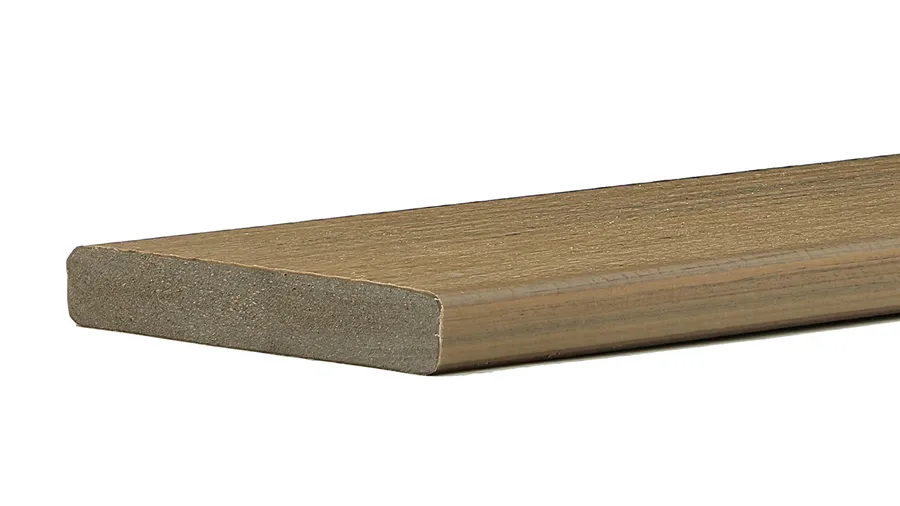
This article will discuss its manufacturing process—from inception to end-of-life scenario. We will delve into how composite decking production compares to that of wood decking and plastic decking in environmental impact, investigating how composite decking contributes to reducing deforestation and landfill waste.
If you want to understand the ecological impact of your deck project, or if you just want to make sure you're choosing the environmentally-friendly path for your deck, we're here to help you make an informed decision. Let’s dive in.
Table of Contents
- The Environment Impact of Composite Decking vs. Other Decking Materials
- Manufacturing Process and Environmental Impact
- Life Cycle of Composite Decking: Production to Disposal
- Role of Sustainable Decking in Reducing Environmental Footprint
- Explore DecksDirect’s Eco-friendly Composite Decking Range
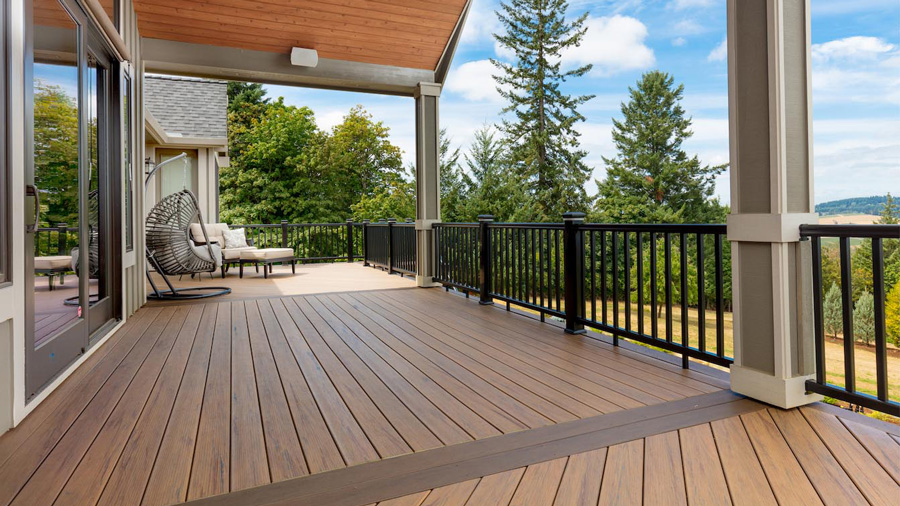
The Environment Impact of Composite Decking vs. Other Decking Materials
| Aspect | Composite Decking | Wood Decking | Plastic Decking |
|---|---|---|---|
| Materials Used | Recycled wood fibers and plastic polymers. Often includes post-consumer recycled content. | Natural wood from trees (virgin material) | 100% virgin plastic, derived from fossil fuels |
| Deforestation Impact | Reduces demand for virgin timber, contributing to lower deforestation rates | Directly contributes to deforestation unless sourced from certified sustainable forests | Does not contribute to deforestation, but high plastic demand impacts fossil fuel extraction |
| Energy Consumption | Moderate energy consumption during manufacturing, primarily during extrusion and cooling | Low energy consumption for cutting and shaping. High energy is used in lumber drying and transportation. | High energy consumption in production due to plastic processing and refining |
| Greenhouse Gas Emissions | Moderate emissions from energy use during manufacturing. Lower than wood in the long term due to less frequent replacement. | Low emissions during production but higher during lumber drying and transportation | Increased emissions from plastic manufacturing and refining |
| Durability | Highly durable, resistant to rot, insects, and moisture. Longer lifespan than wood. | Moderate durability, susceptible to rot, insect infestations, and weathering. Requires regular maintenance. | Low durability, susceptible to weathering and warping |
| Recyclability | Recyclable through take-back programs, reducing waste and resource consumption | Can be recycled, but contaminated or treated wood may be challenging | Difficult to recycle due to the mix of different plastic types and additives. Often ends up in landfills. |
| Maintenance | Low maintenance, no staining, sealing, or painting required | Moderate maintenance; requires staining, sealing, and periodic painting to retain appearance | Low maintenance, resistant to stains, but may fade over time |
| Environmental Impact | Positive impact due to using recycled materials and reduced deforestation | Negative impact from deforestation and high resource consumption | Negative impacts from high energy consumption, plastic pollution, and limited recyclability |
The verdict? Composite decking is a more sustainable option than wood and plastic decking. Its use of recycled materials helps reduce deforestation and waste generation, while its durability and long lifespan reduce the need for frequent replacements.
Wood decking, though a natural material, contributes to deforestation and requires regular maintenance. Plastic decking has a higher environmental impact due to its reliance on fossil fuels, high energy consumption during production, and challenges in recycling.
Composite decking emerges as a more eco-friendly choice, promoting responsible consumption and conservation of natural resources.
Manufacturing Process and Environmental Impact
Composite decking is a modern, eco-friendly decking option. It is made from recycled wood fibers and plastic polymers, usually derived from post-consumer materials like recycled plastic bags, bottles, and reclaimed wood. Blending these components results in a highly durable and low-maintenance decking material that emulates the appearance of natural wood.
How Composite Decking Is Made
The manufacturing process of composite decking involves several stages, from the selection of materials to the final production of deck boards. Here’s a breakdown of the key materials used during production:
- Recycled Wood Fibers. The manufacturing process begins with collecting recycled wood fibers, often sourced from post-industrial wood waste or reclaimed wood from construction sites.
- Recycled Plastic Polymers. Recycled plastic is typically derived from various post-consumer sources like plastic bags, containers, and bottles. A standard 16-foot Trex deck board, for example, uses recycled materials from about 2,250 plastic bags.
- Binding Agents. Binding agents, such as polyethylene or polypropylene, are added to create a cohesive mixture. These agents help hold the wood fibers and plastic polymers together during manufacturing.
- Colorants and Additives. Colorants and other additives, such as UV and mold inhibitors, are introduced into the mixture to achieve the desired appearance and performance characteristics.
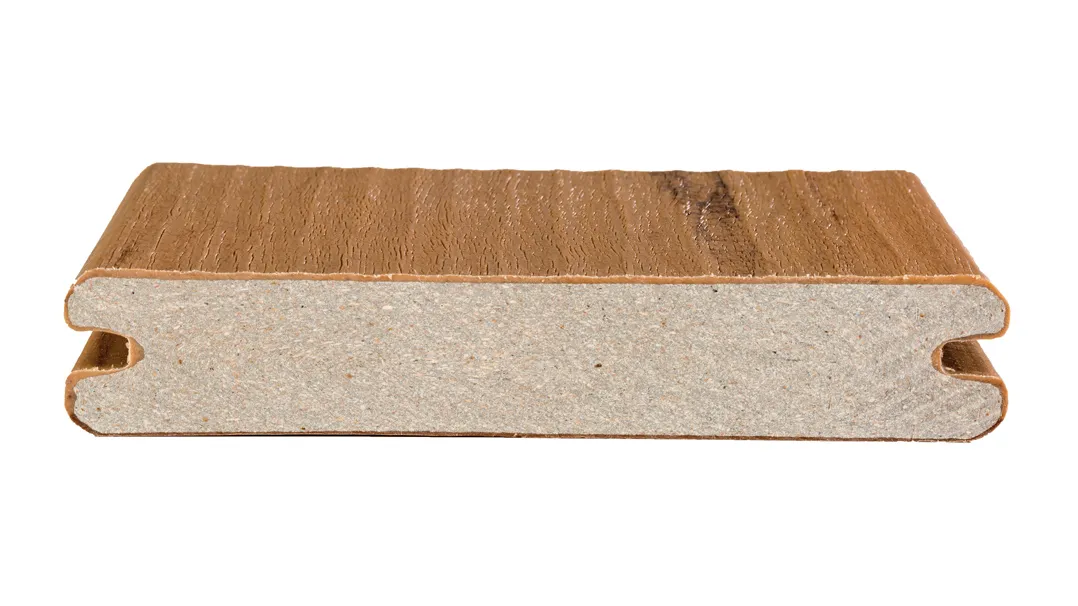
The manufacturing process goes through several phases:
- Mixing and Blending. The recycled wood fibers, plastic polymers, binding agents, and additives are combined precisely in a mixing chamber. The goal is to create a consistent and well-distributed mixture.
- Extrusion. The mixture is then heated and forced through an extrusion process. This involves pushing the material through a shaping die to form the deck boards’ desired profile. The extrusion process creates the characteristic wood-grain patterns found on the surface of composite decking.
- Cooling and Shaping. After extrusion, the newly formed deck boards are cooled to solidify their shape and ensure dimensional stability.
- Cutting and Finishing. The composite panels are cut to the desired length and finished with grooves or channels to allow for installation with hidden fasteners.
Energy Consumption and Emissions
The composite decking process requires energy, primarily in the extrusion and cooling stages. The sustainability of composite decking lies in the use of recycled materials and the reduction in virgin resource consumption.
Composite decking typically has a lower environmental impact compared to traditional wood decking. Traditional wood decking requires logging, transportation, and energy-intensive drying processes, contributing to deforestation, emissions, and habitat disruption.
Though composite decking production involves using plastic derived from fossil fuels, the overall environmental impact is often lower due to the plastic being diverted from landfills and recycled into a durable product with an extended lifespan. And top composite decking brands like Fiberon lean into the sustainability aspect by capturing and reusing almost all the water involved in the manufacturing process.
While manufacturing may still have some environmental implications, choosing composite decking over traditional wood decking can significantly reduce the overall carbon footprint and contribute to a more sustainable approach to outdoor living spaces. TimberTech deck boards, for example, have diverted more than 500 million pounds of waste from landfills by creating their deck boards out of 60% to 85% recycled materials across their various decking lines.
Life Cycle of Composite Decking: Production to Disposal
We’ve touched on the production process of composite decking, but a lot can still happen once it leaves the factories.
Usage
The usage phase of composite decking showcases its durability and low-maintenance attributes, contributing to its long lifespan. Unlike traditional wood decking, composite decking is resistant to rot, insects, and moisture, requiring minimal upkeep. Homeowners do not need to invest in regular staining, painting, or sealing, saving resources and reducing the environmental impact of maintenance activities.
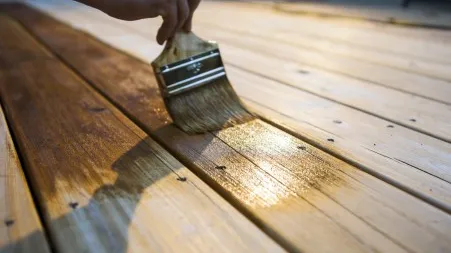
The longevity of composite decking translates to a reduced frequency of replacements. Composite decks can last for decades with proper care, extending the time between installations and lowering the overall consumption of materials.
Learn More: The Ultimate Guide To Composite Decking Maintenance
Disposal
Composite decking faces potential disposal challenges at the end of its serviceable life. Old composite decking may end up in landfills if not recycled, contributing to waste generation. To address this concern, it is essential to promote recycling programs that enable consumers to return their old composite decking for proper recycling. Recycling composite decking allows for the recovery of valuable materials, such as wood fibers and plastic polymers, which can be reused to produce new decking boards.
Recyclability
The recyclability of composite decking is a significant sustainability feature. Many manufacturers have embraced recycling initiatives, offering take-back programs to collect and recycle old composite decking materials. Through these programs, recycled materials can be reintegrated into the manufacturing process, reducing the reliance on virgin resources and minimizing waste.
One can also get a bit creative in recycling composite decking, like selling them to families that need a few materials for their outdoor projects.
Composite decking recycling is a critical step toward a circular economy, where materials are continually reused, creating a closed-loop system that reduces environmental impact and resource depletion. As these recycling programs expand and improve, the ecological benefits of composite decking become even more pronounced.
Role of Sustainable Decking in Reducing Environmental Footprint
As outdoor living spaces become integral to modern lifestyles, choosing eco-friendly materials like sustainable decking options becomes crucial in reducing our ecological footprint and preserving natural resources.
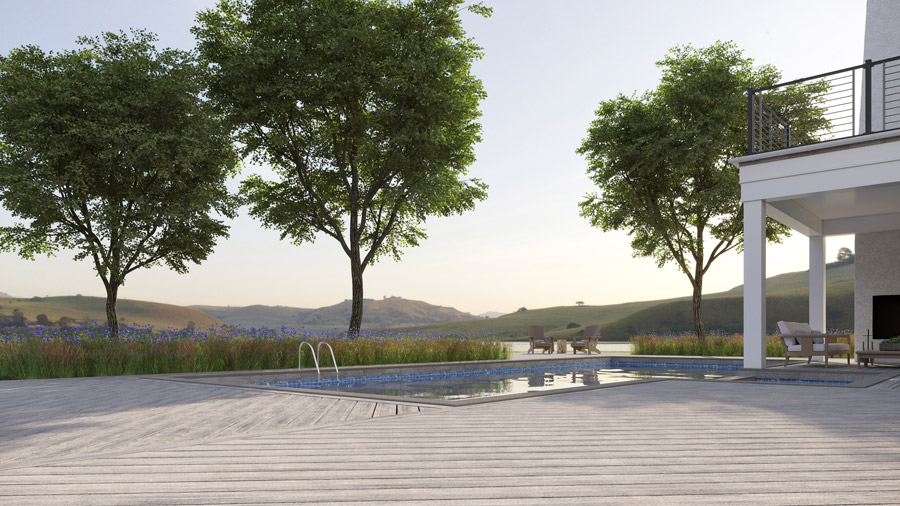
Preserving Forests and Biodiversity
Traditional wood decking from logging activities contributes to deforestation and habitat destruction. In contrast, sustainable decking options actively reduce the demand for virgin wood by utilizing recycled materials. Choosing decking materials that prioritize recycled content and reclaimed resources can contribute to the conservation of forests and biodiversity protection.
Minimizing Waste Generation
Sustainable decking solutions often incorporate post-consumer recycled content, such as plastic bags and containers, reducing waste in landfills or polluting natural ecosystems. This approach aligns with the principles of a circular economy, where materials are continuously recycled and reused, promoting sustainability.
Lowering Carbon Footprint
Sustainable decking options’ manufacturing process results in lower greenhouse gas emissions. Sustainable decking helps people reduce their carbon footprint and mitigate the effects of climate change.
Promoting Longevity and Durability
Sustainable decking materials are durable and resistant to the elements, ensuring a longer lifespan with minimal maintenance. Investing in high-quality decking allows homeowners to contribute to responsible consumption, avoiding frequent replacements that consume additional resources and energy.
Encouraging Recycling Initiatives
Many sustainable decking manufacturers offer recycling programs, encouraging consumers to return their old decking for proper recycling. Actively participating in these initiatives lets individuals close the loop in the product life cycle, allowing materials to be reused and reducing waste. Supporting such initiatives fosters a culture of responsible consumption and reinforces the importance of sustainable practices.
Inspiring Eco-Conscious Choices
Sustainable decking is a visible example of how individuals can make eco-conscious choices without compromising aesthetics or functionality. Sustainable decking sets an example by showcasing attractive and environmentally responsible outdoor spaces, encouraging wider adoption of green building materials and practices.
Sustainable decking plays a vital role in environmental conservation and responsible consumption. Choosing these eco-friendly materials for outdoor spaces creates beautiful and functional settings and demonstrates a commitment to preserving natural resources and ensuring a sustainable future.
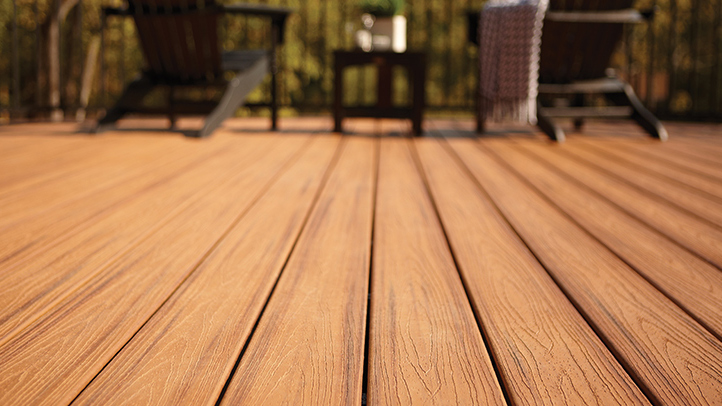
Explore DecksDirect’s Eco-friendly Composite Decking Range
As the world grapples with pressing environmental challenges, the significance of sustainability in choosing building materials cannot be overstated. Opting for eco-friendly solutions like composite decking conserves natural resources, reduces waste, lowers carbon emissions, and, more importantly, sets a positive example for future construction practices.
If you want to transform your outdoor space responsibly, check out our selection of sustainable composite deck boards. Our deck experts scour the market to find the top-quality composite decking brands and collections, so you know you're getting deck boards that will be beautiful and long-lasting - in addition to eco-friendly.
Shop Composite DeckingMake a lasting impact on our planet by making conscious choices in your building materials. Embrace sustainability, choose composite decking, and join the movement toward a greener and more responsible future. Get your sustainable composite decking from DecksDirect today and take the first step toward a more eco-friendly outdoor space.
